


xxxxxThe Asiento de Negros (Negroes’ Contract) was introduced by Charles I of Spain in 1518 (H8). It was a monopoly granted for the supply of slaves to work in the American Spanish colonies. Over the years France, Portugal and Britain had entered into this lucrative contract, as had a number of individual Spaniards. Granted to Britain by the Treaty of Utrecht in 1713, it required the supply of 4,800 slaves annually over the next 30 years. As it so happened, the contract did not prove very profitable, and led to the so called War of Jenkins Ear between Spain and Britain in 1739 (G2). Britain terminated the contract in 1750, by which date some 450,000 Africans had been transported to South America by the Asiento.
ASIENTO DE NEGROS 1713 (AN)
AN-
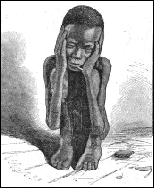 xxxxxAs we have seen, the Asiento
de Negros (Negroes' Contract) was
introduced by Charles I of Spain in 1518 (H8).
It was an agreement between the Spanish crown and another party -
xxxxxAs we have seen, the Asiento
de Negros (Negroes' Contract) was
introduced by Charles I of Spain in 1518 (H8).
It was an agreement between the Spanish crown and another party -
xxxxxThe first asentista
(contractor) was a Genoese company which agreed to supply 1,000
slaves over an eight-
xxxxxAs it so happened, the
company did not find the enterprise very profitable. War, for
example, often prevented access to the American markets, and the
high annual tax imposed by the Spanish crown was sometimes greater
than the profit being made. And, as we shall see, the unauthorised traffic dealing in
the slave trade soured relations between Spain and Britain, leading
in 1739 (G2) to
a conflict known as the War of Jenkins’ Ear. The Asiento was renewed
at the Treaty of Aix-
Including:
Black African
Slave Trade

xxxxxThe Black
African Slave Trade across the Atlantic was
begun in 1502 (H7).
Beginning as a trickle, it developed into a torrent. It is estimated
that in total some 8 to 17 million Africans were transported to the
New World by 1870. Slavery had been a fact of life since the
earliest “civilisations”, but the transatlantic trade was
particularly inhuman, if only because of the dreadful conditions
endured -
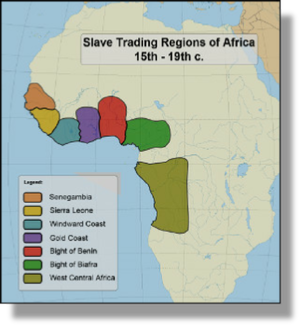 xxxxxAs we have seen (H7
1502), the Portuguese, when exploring along the west coast of
Africa, were among the first to begin the Black
African Slave Trade. As early as 1444 they had begun
importing slaves from West Africa to work on farms and estates in
Portugal. At the same time a similar traffic was being carried out by
Arab traders in North Africa. Young men and women from the interior of
the continent were being shipped to markets in the Middle East and
India. The need to take the black African to the New World arose in
the first place because it was found that they, unlike the indigenous
people (reduced in number by warfare and European diseases), were more
able to cope with the harsh life implicit in forced labour. Hence the
introduction by Spain of the Asiento de Negros
in 1518.
xxxxxAs we have seen (H7
1502), the Portuguese, when exploring along the west coast of
Africa, were among the first to begin the Black
African Slave Trade. As early as 1444 they had begun
importing slaves from West Africa to work on farms and estates in
Portugal. At the same time a similar traffic was being carried out by
Arab traders in North Africa. Young men and women from the interior of
the continent were being shipped to markets in the Middle East and
India. The need to take the black African to the New World arose in
the first place because it was found that they, unlike the indigenous
people (reduced in number by warfare and European diseases), were more
able to cope with the harsh life implicit in forced labour. Hence the
introduction by Spain of the Asiento de Negros
in 1518.
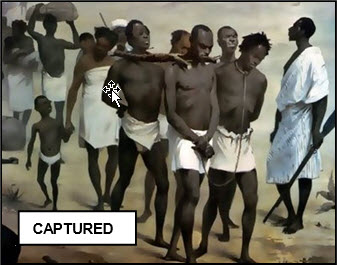 xxxxxWith the development in the Americas of
large plantations for the production of sugar, coffee, cotton,
tobacco, and rice, plus the need for labour in the mining industry,
this traffic grew to gigantic proportions. Ground had to be cleared
and buildings built, crops had to be sown and reaped, mines had to be
dug and worked. As a result, from the middle of the 16th century until
1870, when the slave trade virtually came to an end, it is estimated
that 8 to 17 million African slaves were transported to the New World,
with a peak of some 6 million arriving in the 18th century. The vast
majority of these slaves came from West and Central Africa. Of the
total number, nearly half went to the Caribbean islands and the
Guianas, almost 40 percent to Brazil, and some 6 percent to mainland
Spanish America. Surprisingly enough, under 5 percent went to North
America.
xxxxxWith the development in the Americas of
large plantations for the production of sugar, coffee, cotton,
tobacco, and rice, plus the need for labour in the mining industry,
this traffic grew to gigantic proportions. Ground had to be cleared
and buildings built, crops had to be sown and reaped, mines had to be
dug and worked. As a result, from the middle of the 16th century until
1870, when the slave trade virtually came to an end, it is estimated
that 8 to 17 million African slaves were transported to the New World,
with a peak of some 6 million arriving in the 18th century. The vast
majority of these slaves came from West and Central Africa. Of the
total number, nearly half went to the Caribbean islands and the
Guianas, almost 40 percent to Brazil, and some 6 percent to mainland
Spanish America. Surprisingly enough, under 5 percent went to North
America.
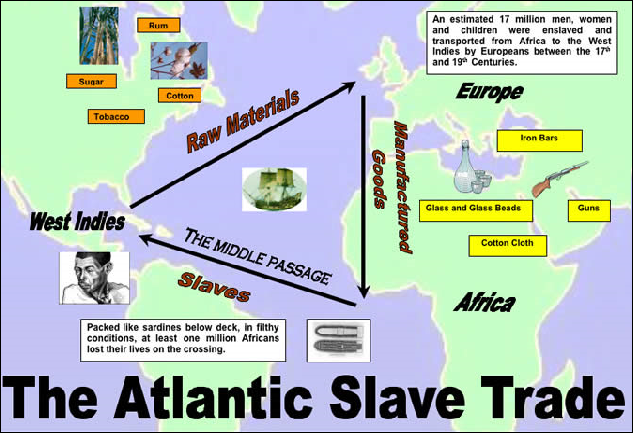 xxxxxThis trans-
xxxxxThis trans-
xxxxxThis proved a very profitable commercial enterprise for the tribal chiefs who sold the slaves, the ship owner who transported them, the planter who put them to work, and the merchants and shipbuilders in Europe who grew rich from the expanding export and import markets. There was only one set of losers: the slaves themselves. This highly beneficial system of trade was accompanied by a degree of human suffering which, for size and duration, had not been witnessed before, nor surpassed since.
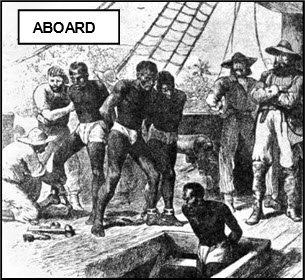
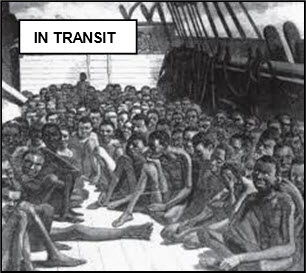 xxxxxSlavery, as we know, has been practised
since the very beginning of human society, be it for sacrifice,
warfare or sheer hard labour, but the transatlantic traffic was
particularly degrading, harsh and inhuman, if only because of the
dreadful conditions which the slaves were forced to endure on the
“Middle Passage”, the long sea journey to the Americas. Having been
captured by local African chiefs, they were herded aboard the ships.
Here they were manacled for the entire journey, and stowed tightly on
shelves alongside each other, most unable to stand, some even unable
to sit up. Because of the atrocious conditions and the spread of
disease, close to a third died during the three month journey.
xxxxxSlavery, as we know, has been practised
since the very beginning of human society, be it for sacrifice,
warfare or sheer hard labour, but the transatlantic traffic was
particularly degrading, harsh and inhuman, if only because of the
dreadful conditions which the slaves were forced to endure on the
“Middle Passage”, the long sea journey to the Americas. Having been
captured by local African chiefs, they were herded aboard the ships.
Here they were manacled for the entire journey, and stowed tightly on
shelves alongside each other, most unable to stand, some even unable
to sit up. Because of the atrocious conditions and the spread of
disease, close to a third died during the three month journey.
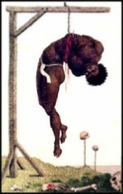 xxxxxAnd on arrival in the New World they were
treated like animals, and often branded like them. Families and tribes
were broken up, and women and men alike were forced into long hours of
hard labour, be it on the plantations or in the mines. For the vast
majority life was brutal. For some it was also short. It is estimated
that one in three died within five years. For those who under-
xxxxxAnd on arrival in the New World they were
treated like animals, and often branded like them. Families and tribes
were broken up, and women and men alike were forced into long hours of
hard labour, be it on the plantations or in the mines. For the vast
majority life was brutal. For some it was also short. It is estimated
that one in three died within five years. For those who under-
xxxxxThe first organised
denunciation of slavery in the Americas came from the Quakers in the
1720s, but in England, as we shall see, it was the politician
William Wilberforce who led the anti-
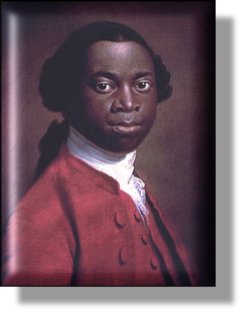 xxxxxIncidentally, a
graphic and distressing account of the life of a slave was given in
1789 by Olaudah Equiano (1745-
xxxxxIncidentally, a
graphic and distressing account of the life of a slave was given in
1789 by Olaudah Equiano (1745-
xxxxxAlong with his fellow
slaves, he endured some brutal treatment, but he was eventually
bought by a British naval officer and, after working some years as a
sailor, was sent to England to be taught to read and write. He was
then sold to a Quaker merchant in the Leeward Islands but, being
allowed to make some money by trading, he finally purchased his
freedom. He then returned to England and gave valuable support to
Granville Sharpe and Thomas Clarkson, the leading members of the
Society for the Abolition of the Slave Trade. His autobiography -
Acknowledgements
Child Slave:
date and artist unknown. Map (Africa):
licensed under Creative Commons. User: Grin20 – en.wikipedia.org.
Captured: date and artist unknown – from The History of Slavery and the Slave
Trade by the American writer William O. Blake (c1800-


